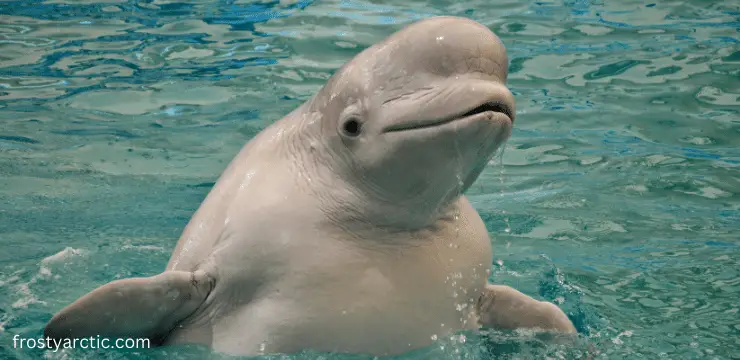Beluga whales live in the Arctic and Subarctic Oceans and the Northern Hemisphere seas. They also live in the regions of Alaska, Greenland, Canada, and Russia. They prefer to live in the shallow, tidal waters of coastal bays and inlets, although they are also comfortable in the open, saltwater environments.
This article will show where these water creatures live and their habitat. Why do they migrate and where do they migrate? Beluga lovers and skeptics, please feel free to comment and share your opinion on this topic.
Where Do Beluga Whales Live?
Beluga whales live in one of the most inhospitable, coldest and longest inhabited places on the planet – the Arctic and Sub-Arctic oceans.
The climate of these waters is extreme and the water is filled with huge, saline pools and sea ice.
They can survive in the frigid waters of the arctic and subarctic environments because of a thick covering of fat called blubber and thick skin. Belugas also lack a dorsal fin, allowing them to swim over ice.
To date, NOAA Fisheries has documented five distinct populations of beluga whales in Alaskan waters. There are five different populations of beluga whales, and they are:
- Cook Inlet
- Beaufort Sea
- Bristol Bay
- Eastern Chukchi Sea
- Eastern Bering Sea
Every stock is unique and genetically and geographically distinct from the others due to differences in migration patterns and favored habitats.
All these stocks of beluga whales are considered endangered and are in danger of becoming extinct within the next few decades.
Unusually cold winters and environmental pollution are two of the biggest threats to the survival of these whales.
Furthermore, beluga whales live in small pods. These pods are called small groups. As vocal communicators, they use various sounds, including clicks, whistles, and clangs, to convey information to one another in groups.
The beluga has a wide range of sound mimicry abilities, making it a friendly mammal living in cold water with warm behavior.
At What Temperature Do Beluga Whales Live?
Beluga whales can live at a temperature of 0°C (32°F). In the frigid seas of the arctic and subarctic, where temperatures can drop to as low as 0 degrees Celsius, belugas can be found swimming around icebergs and ice floes.
When not far from land, belugas frequent the seas just off the coast, where the water is usually only a few inches deep.
They may prefer deeper waters, too. During the summer, numerous populations congregate in estuaries and river basins with warm water.
This animal, the beluga, appears to be well adapted to both the frigid ocean and the warmer freshwater.
According to National Geographic, belugas migrate southward to slightly warmer temperatures when the ocean begins to freeze.
Do They Mostly Stay in The Deep Sea?
Yes, beluga whales mostly love and enjoy staying in the deep sea. The Arctic Ocean and its surrounding seas are home to beluga whales. They can also be seen in major rivers at specific seasons.
During certain seasons of the year, belugas populate huge rivers like the Amur in Russia, the Yukon in Canada, and St. Lawrence in the United States.
Specimens of the beluga whale have been discovered as far north as 1,995 kilometers (1,240 miles) up the Amur River and 965 kilometers (600 miles) up the Yukon River.

Although they are known as slow swimmers, they can dive to depths of 700 meters (2,300 feet).
In the summer, they congregate around the coasts of Alaska, western Greenland, northern Canada and northern Russia in deep seas between 76°N and 80°N.
Where Do Beluga Whales Live in Canada?
Beluga whales mostly live in Canada in the province of Newfoundland and Labrador. Five distinct populations of beluga may be found in the waterways of Canada, one of which is in the Saint Lawrence River.
The remaining four populations are as follows:
- The Eastern High Arctic/Baffin Bay population is regarded as being in a state of special concern
- The Cumberland Sound population, which is considered to be in a state of threatened status
- The Ungava Bay population is recognized as an endangered population and
- The Eastern Hudson Bay population which are also recognized as endangered populations.
Oceanariums worldwide have started keeping belugas as display animals due to their popularity. The Vancouver Aquarium and Marineland in British Columbia have had them on exhibit for a good number of years (in Niagara Falls).
Since Canada’s regulations on the practice have become more stringent in recent years, Russia has been meeting the rising demand for live belugas worldwide.
In the past, many belugas kept in captivity were captured in the western part of Hudson Bay.
Do Beluga Whales Migrate? Why?
Yes, beluga whales migrate to different places. Not all, but most belugas migrate from one place to another. Belugas are highly social creatures that form pods consisting of a few individuals to hundreds of whales to forage and migrate.
These mammals mostly live in Arctic and Sub-Arctic areas. Since the Arctic begins to freeze in the fall, they make their way south.
When the ice melts in the spring, they travel back to the north to reclaim their grazing grounds.
In the warmer months, you can find them around the mouths of rivers and sometimes even further upstream.
One beluga was observed in Alaska, swimming a thousand kilometers inland up the Yukon River.
However, there are other populations that do not engage in this migratory behavior, and these can be found in the Cook Inlet in Alaska and the St. Lawrence estuary in Canada.
Now, the question arises here, why do the belugas migrate to different places?
They migrate when the Arctic water starts freezing. Arctic ice traps animals, making them easy targets for polar bears, killer whales, and indigenous people.
However, beluga whales are not the only animals to migrate. This behavior is common among many animals.
When And Where Do They Migrate?
They usually migrate when the weather conditions start changing. While some beluga populations engage in seasonal migrations, others consistently reside in the same restricted area throughout the year.
Environmental circumstances determine migration behavior.
As autumn approaches and the ice pack continues to expand, most beluga whales head south.
One population spends the summer at the estuary of the Mackenzie River in the Northwest Territories of Canada. It then travels approximately 3,105 km to the southwest to spend the winter along the coastal areas of the Bering Sea.
The fall season is when other groups of belugas travel farther north. During the winter, belugas that spend the summer in the estuaries of Hudson Water make their way further north into the open bay.
Do Beluga Whales Live in Alaska?
Yes, evidently, they live in Alaska. Five distinct populations of beluga whales are found within the state of Alaska.
These populations can be found in Cook Inlet, Bristol Bay, the eastern Bering Sea, the eastern Chukchi Sea, and the Beaufort Sea.
Bristol Bay and Cook Inlet inhabitants are assumed to stay within their respective territories throughout the year.
The populations that live in the eastern Bering Sea, eastern Chukchi Sea, and the Beaufort Sea spend the winter in the Bering Sea, and then during the summer, they return to their native habitats.
Final Words
Beluga whales live in a very cold climate and in harsh conditions, like in the Arctic and Sub-Arctic areas. However, they have adapted to these environmental conditions and do not suffer too much.
Mostly belugas migrate during the fall and move to northern waters during the summer. I hope you enjoyed reading the article and learned something new about these awesome mammals – belugas.



3 thoughts on “Where Do Beluga Whales Live? Amazing Habitat Facts!”